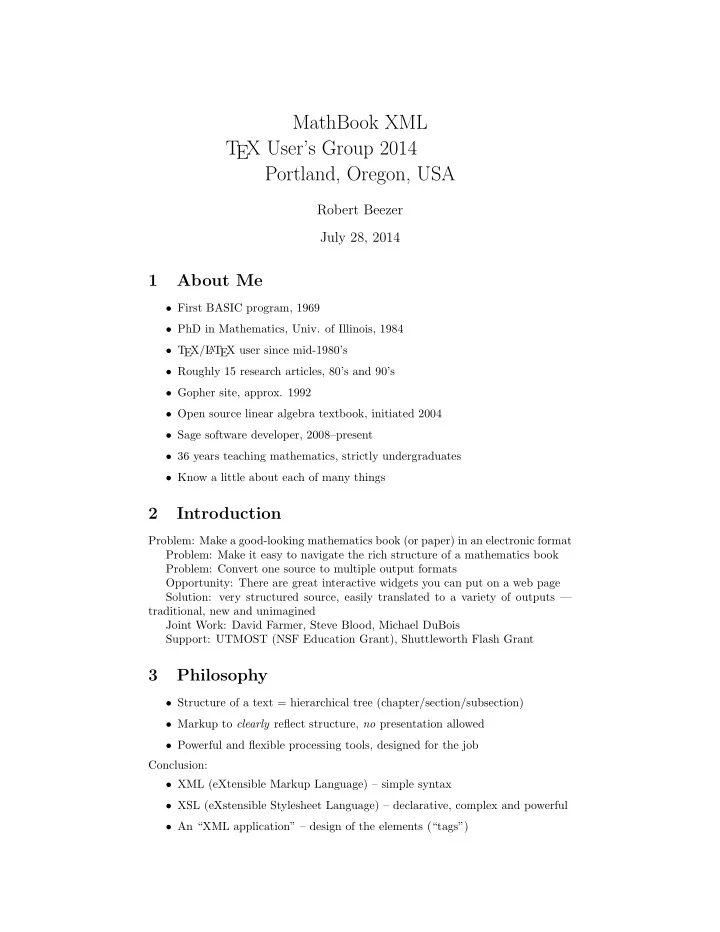

MathBook XML T EX User’s Group 2014 Portland, Oregon, USA Robert Beezer July 28, 2014 1 About Me • First BASIC program, 1969 • PhD in Mathematics, Univ. of Illinois, 1984 • T EX/L A T EX user since mid-1980’s • Roughly 15 research articles, 80’s and 90’s • Gopher site, approx. 1992 • Open source linear algebra textbook, initiated 2004 • Sage software developer, 2008–present • 36 years teaching mathematics, strictly undergraduates • Know a little about each of many things 2 Introduction Problem: Make a good-looking mathematics book (or paper) in an electronic format Problem: Make it easy to navigate the rich structure of a mathematics book Problem: Convert one source to multiple output formats Opportunity: There are great interactive widgets you can put on a web page Solution: very structured source, easily translated to a variety of outputs — traditional, new and unimagined Joint Work: David Farmer, Steve Blood, Michael DuBois Support: UTMOST (NSF Education Grant), Shuttleworth Flash Grant 3 Philosophy • Structure of a text = hierarchical tree (chapter/section/subsection) • Markup to clearly reflect structure, no presentation allowed • Powerful and flexible processing tools, designed for the job Conclusion: • XML (eXtensible Markup Language) – simple syntax • XSL (eXstensible Stylesheet Language) – declarative, complex and powerful • An “XML application” – design of the elements (“tags”)
4 Goals • Simple markup: sensible names and abbreviations, few attributes • No more complicated than L A T EX • Excellent support for authors • Knowledge embedded in system (such as MathJax configuration) • Flexibility through processing switches (e.g. numbering depth) • Industrial-strength converters to popular formats (reference design) All of this is possible with very few compromises 5 MathBook XML The principal (only?) “product” of this project. • An “XML application”, a set of elements, attributes and their relationships • Easy for an author to comprehend • Very few attributes, none obtuse • No presentation. Really • Easy cross-references: xml:id="a-label" and <xref ref="a-label"> • L A T EX syntax for mathematics (no attempt to be semantic here) • Define L A T EX convenience macros once (e.g. for notation) • Minimal escaped characters: & generally, \ lt, \ gt, & in math • Designed for authors, not archivists. Practical 6 Conversion to L T EX A • What you would expect. . . • Human-readable L A T EX • Money-back guarantee for the cautious • All customizations in the preamble, only as required • Selective about packages: “standard” and well-supported • A body you could easily style differently • pdflatex or xelatex compatible • Processing switches: fontsize, page geometry, numbering depth, . . . • Language-independent: e.g. “Chapter”, “Theorem”, • Unicode-aware 2
7 Conversion to HTML • Writing HTML with clear separation from presentation (CSS) • Mathematics rendering from MathJax library • Fonts, Code Prettifier from Google • Interactive elements (now): Video, Sage Cell, GeoGebra, Program Listings • Interactive elements (possible): Audio, Skulpt, WebRTC, WeBWorK, • SVG graphics from TikZ, Asymptote, Sage sources • Numbering, cross-referencing matches L A T EX version (equations, too) • Extensive code-sharing with L A T EX conversion 8 Conversion to Sage Worksheets • “Sage Notebook” is web interface for Sage worksheets (c. 2006-2008) • Worksheet: HTML plus some non-standard markup, graphics files, in tar archive • My original itch: L A T EX to XHTML (tex4ht) to worksheet(s), (c. 2010) • Now: about 200 lines of additional XSLT, 200 lines of Python 9 Demonstrations Tom Judson’s Abstract Algebra: Theory and Applications Chapter 5, Permutation Groups Open Source’d in early 2009: http://abstract.ups.edu • PDF/Print • HTML/Webpages • Sage Worksheets in Sage Notebook • Sage DocTests (another itch) Explorations in Algebraic Graph Theory , with Chris Godsil 10 Existing Projects • RAB: This presentation • RAB: traditional printed monograph on Combinatorial Designs (CUP) • RAB: A Second Course on Linear Algebra (open-source now) • Judson: Abstract Algebra: Theory and Applications (beta: AY 2014-15) • Judson, Hitchman: Ordinary Differential Equations Textbook (in-progress) • RAB, Godsil: Explorations in Algebraic Graph Theory with Sage • Others at initial stages 3
11 To Do Development priority: user requests First things first. • Knowlification for HTML, selectable with processing switches • Finish Document Type Definition (DTD) • Convert FCLA’s one-off XML to MBX • Tables and lists need work • Generate back matter automatically: index, notation list, list of . . . • New converters: Sage Math Cloud, iPython Notebooks • New converters: EPUB 3 EDUPUB Specification, DocBook, Word XML (?) • Suggestions welcome! 12 Conclusion • MathBook XML is fairly stable now • Ready for authoring, if . . . you are prepared for a few changes • Converters are firming up, and provide modular base for other formats • Main site: http://mathbook.pugetsound.edu • Announcements and discussion at the mathbook-xml-support Google Group 4
Recommend
More recommend